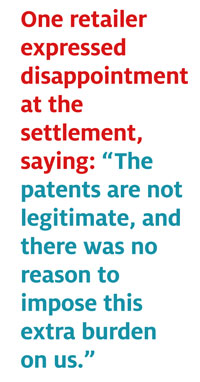Mar 02, 2015Every month, it becomes clearer that adoption of radio frequency identification is ramping up in the apparel retail sector. As I pointed out in the Nov./Dec. 2014 issue of this magazine, 2014 stood out as a year in which many retailers worldwide announced plans to introduce or expand item-level initiatives to improve inventory accuracy (see Apparel Edges Toward the Tipping Point). Already this year, Marc O'Polo, a German casual apparel company, announced that it had adopted an RFID solution to track its products across the entire supply chain, from its distribution center to 86 of its stores throughout Europe. And the buzz at the National Retail Federation conference, which took place in January in New York City, was about RFID and omnichannel shopping.
Meanwhile, some retailers that have deployed RFID to improve inventory accuracy are now using the technology to gain a competitive advantage (see Building on Retail's RFID Foundation and Second to None). Apparel retailers that have been watching these developments from the sidelines are now showing more interest in deploying the technology. In fact, many now realize they are behind the curve and have to get up to speed quickly.
To meet this growing interest, RFID Journal is expanding its coverage of the retail sector at its annual RFID Journal LIVE! conference and exhibition, which will be held on Apr. 15 to 17 in San Diego, Calif. There will be a strong focus on education, and retailers that have deployed RFID will discuss the benefits they're achieving and why they're rolling out the technology to additional stores.
One session in the Item-Level Retail and Apparel Workshop will provide an introduction to the fundamentals of the technology. Another session will explain the tagging guidelines, developed by the GS1 US Item–Level RFID workgroup, for passive UHF RFID based on the Electronic Product Code standards. The guidelines for where to place tags, what types of tags are suitable for certain products and other critical issues are designed to smooth RFID adoption for retailers.
Rupert Thorpe, senior manager for selling support development at John Lewis, a leading U.K. department store, will explain how the retailer integrated RFID and its legacy systems, enabling it to track and manage 25,000 SKUs across selected fashion assortments. Thorpe will also discuss how John Lewis plans to roll out item-level RFID to more stores in 2015.
In addition, a panel of retailers—including Richard Jenkins, head of RFID strategic development at Marks & Spencer, and Joseph Granato, director of global initiatives at Lululemon Athletica—will discuss how and where they are benefiting from using RFID technology today and which applications will deliver additional benefits once all items are tagged.
In the Retail/Apparel track, Jenkins will go into more depth about Marks & Spencer's use of passive UHF RFID to track and manage apparel and all general merchandise. The British retailer expanded its rollout from 2012 to 2014 to cover 380 of its largest
U.K. stores and more than 95 percent of its apparel and home goods. The firm has been investigating and conducting trials of new uses of the technology across the entire scope of its operations. Jenkins will explain why M&S expects the technology's future benefits to provide even greater merchandise visibility and accuracy, from supplier through distribution centers and into stores, to support its omnichannel efforts.
Hans Petter Hübert, supply-chain manager for Scandinavian clothing company Moods of Norway (MoN), will explain how the retailer is using RFID technology to better manage inventory in its 13 stores. The system not only provides 98 to 99 percent inventory accuracy but also reduces the amount of time employees spend performing manual inventory checks, thereby enabling more frequent checks. During a six-month pilot, RFID boosted sales of men's shirts and suits by double digits.
Other featured speakers will include Simon Tam, CTO of Ritani Jewelry, which is using RFID to enable retailers that sell its jewelry to automatically display information about merchandise customers asked to see, and to allow those shoppers to share the items' images with friends after making a purchase. And Antonio Almeida, superintendent of Brascol, a leading wholesaler and distributor of babies' and children's clothing in Brazil, will explain why his company is using RFID to optimize inventory control, increase operational savings and improve the service experience for customers.
Education opportunities also will come from networking with retailers from the United States and other countries. The Auburn University's RFID Research Center will host an invitation-only lunch for retailers and suppliers, to discuss barriers to deployment and how to break through them. The exhibit hall will also feature a wide array of RFID products aimed at retailers, including overhead readers, handheld readers, smart displays and software applications.
Those new to RFID Journal LIVE! can create a personal event planner by selecting sessions on the agenda to attend and by researching exhibitors on RFID Connect. Attendees can also get personalized advice on which sessions to attend and which exhibitors to see by taking advantage of our Concierge Service prior to the event or visiting the Ask the Experts booth on site.


